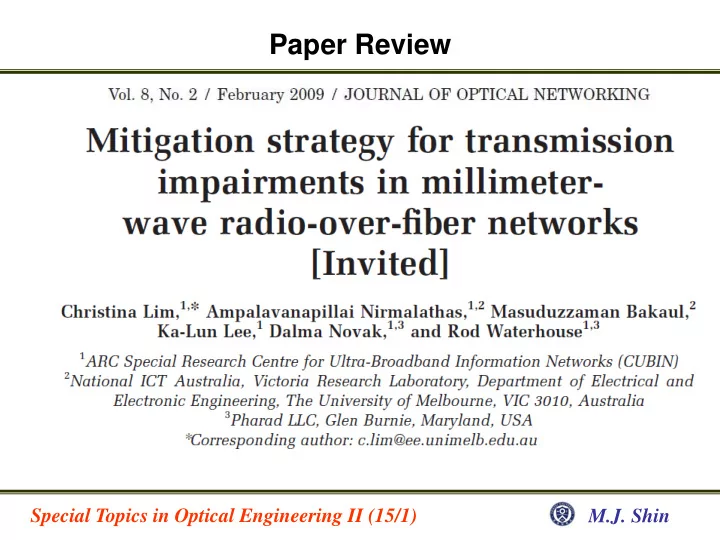

Paper Review Special Topics in Optical Engineering II (15/1) M.J. Shin
Contents • Introduction • Optical Impairments in Fiber-Wireless Links • Strategies to Overcome Impairments - Optical Fiber Dispersion - Optical Spectral Efficiency - Improving Optical Modulation Depth - Base-Station(BS) Technologies - Front-End Nonlinearity • Conclusion Special Topics in Optical Engineering II (15/1) M.J. Shin
Introduction • Hybrid fiber-wireless networks - Advantages High bandwidth Spectral congestion X High-capacity broadband wireless services - Disadvantages Inherent high propagation loss Need to deploy picocellular & microcellular architecture for efficient geographical coverage • Simplify BS, centralize control center Special Topics in Optical Engineering II (15/1) M.J. Shin
Centralized Control Architecture • Typical hybrid fiber-wireless scenario • Strategy to achieve centralized control architecture - Move hardware intelligence to Central Office(CO) - Optically distribute radio signal at mm-wave Simplify antenna BS • Susceptible to impairments Special Topics in Optical Engineering II (15/1) M.J. Shin
Optical Impairments • MM-wave ROF link • Additional impairments - Inefficient spectral usage - Phase decorrelation(optical carrier, radio signal) Special Topics in Optical Engineering II (15/1) M.J. Shin
Strategies to Overcome Impairment • Optical Fiber-Dispersion • Optical Spectral Efficiency • Improving Optical Modulation Depth • Base Station Technologies • Front-End Nonlinearity Special Topics in Optical Engineering II (15/1) M.J. Shin
Optical Fiber-Dispersion • Received RF power varies by phase difference • RF power: fiber dispersion, transmission distance, mm-wave frequency • RF power varies periodically, power suppression occur at certain frequency Normalized RF Power(dB) Modulating Frequencies Special Topics in Optical Engineering II (15/1) M.J. Shin
Mitigation Techniques for Dispersion Effect • OSSB+C Modulation • External Filtering • Optical Carrier Suppression Technique • Chirped Fiber Gratings • Fiber Nonlinearities Special Topics in Optical Engineering II (15/1) M.J. Shin
Dispersion Effect Mitigation Techniques • Dual-electrode Mach-Zehnder modulator(DEMZM) OSSB+C • Biased quadrature & 90 degree phase shift between two electrodes Special Topics in Optical Engineering II (15/1) M.J. Shin
Other Solution for Dispersion • External Filtering - Reflect unwanted optical sideband(FBG) Limited flexibility implemented difficult - • Optical Carrier Suppression Technique - Bias at null point - Half the desired modulating frequency needed - Need large RF driver power to obtain desirable modulation depth (nonlinear) • Fiber Nonlinearities • Phase conjugation Special Topics in Optical Engineering II (15/1) M.J. Shin
Optical Spectral Efficiency • Interleaving multiple mm-wave optical signals - Fiber Bragg gratings(FBGs) - Arrayed waveguide gratings(AWGs) Special Topics in Optical Engineering II (15/1) M.J. Shin
AWG Based Wavelength Interleaving Strategy • DEMUX based on 2XN AWG & high-finesse Fabry-Perot etalon • Etalon separate optical carriers from sideband signal • AWG routes optical carriers and corresponding sidebands to same output Etalon: Monolithic interferometric devices containing two parallel reflecting surfaces DEMUX using 2 X N AWG for wavelength-interleaved channels Special Topics in Optical Engineering II (15/1) M.J. Shin
Improving Optical Modulation Depth • Low modulation efficiency at mm-wave radio signal • Huge difference between optical carrier power & modulated sideband power • Optical filtering by FBGs remove portion of optical carrier • Improve modulation efficiency Special Topics in Optical Engineering II (15/1) M.J. Shin
Optical Spectrum of OSSB+C with FBG • OSSB+C signal carrying 155Mbits/s at 35GHz • FBG: 95% reflectivity(14dB) • Bit-error-rate(BER) improved Special Topics in Optical Engineering II (15/1) M.J. Shin
Need for Base-Station Technologies • Full-duplex mm-wave fiber-wireless network need optical interface @ BS • Optical source with narrow linewidth at well-specified wavelength minimize phase noise degradation • Ultra-stable, low-cost, narrow-linewidth optical source difficult to realize Wavelength assignment & source monitoring move to CO • Source-free base station - CO generate downlink signal & uplink optical carrier with different wavelength - Wavelength reuse technique Special Topics in Optical Engineering II (15/1) M.J. Shin
Wavelength Reuse Technique • OSSB+C modulated signal • 50% for downstream RF signal • 50% reuse for uplink optical carrier Special Topics in Optical Engineering II (15/1) M.J. Shin
Front – End Nonlinearity • Wireless multicarrier network linearity important(reduce IMD products) • Feed-forward technique - Suppress IMD3 & reduce laser relative intensity noise(RIN) • Predistortion technique - Require predistorter at the source to combat IMD - Same amplitude opposite phase • Removing dominant IMD technique Special Topics in Optical Engineering II (15/1) M.J. Shin
Linearization with removing dominant IMD • Input two tone signal( ω 1 , ω 2 ) • Nonlinear DEMZM, photodetector other optical components generate • ω c ─ω 1 + ω 2 , ω c + ω 1 ─ω 2 dominant IMD3 Special Topics in Optical Engineering II (15/1) M.J. Shin
Linearization with removing dominant IMD • Remove dominant IMD3 with filter(carrier-to- interference ratio ↑) • Split optical carrier recombine with clean optical carrier • Not clear all IMD3 but remove large portion Special Topics in Optical Engineering II (15/1) M.J. Shin
Conclusion • Introduction of hybrid fiber-wireless networks - High bandwidth - Spectral congestion X - Inherent high propagation loss • Optical Impairments in Fiber-Wireless Links • Strategies to Overcome Impairments - Optical Fiber Dispersion - Optical Spectral Efficiency - Improving Optical Modulation Depth - Base-Station(BS) Technologies - Front-End Nonlinearity Special Topics in Optical Engineering II (15/1) M.J. Shin
Recommend
More recommend